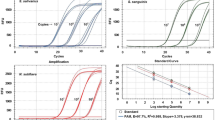Abstract
Forensic saliva identification represents an increasingly useful auxiliary means of crime investigations, particularly in sex crimes. Salivary bacteria detection techniques have been shown to be viable methods for identifying the presence of saliva. A one-pot method is described for the fabrication of bovine serum albumin-stabilized SiC nanoparticles (SiC@BSA NPs). The SiC@BSA NPs were conjugated to antibacterial peptide GH12 to allow for fluorometric detection and imaging of bacteria in saliva. More specifically, the nanoprobe, with fluorescence excitation/emission maxima at 320/410 nm, was used to detect the oral bacteria S. salivarius levels. The detection limit is 25 cfu·mL−1, and the assay can be performed within 40 min. The nanoprobe was also used to detect bacteria in forensic body fluids including blood, urine, and semen. In all cases, positive results were obtained with (mixed) samples containing saliva, while other saliva samples without saliva showed negative results. Fluorescent images of S. salivarius cells were obtained by implementing a high-content image analysis system. These results suggest that this new nanoprobe can be applied to screen for forensic saliva stains.

Schematic representation of the preparation of SiC@BSA-GH12 nanoprobe for fluorometric detection and imaging of S. salivarius in saliva.






Similar content being viewed by others
References
Auvdel MJ (1986) Amylase levels in semen and saliva stains. J Forensic Sci 31(2):426–431
Akutsu T, Watanabe KY, Sakurada K (2010) Applicability of ELISA detection of statherin for forensic identification of saliva. Int J Legal Med 124(5):493–498
Nakanishi H, Kido A, Ohmori T, Takada A, Hara M, Adachi N, Saito KJFSI (2009) A novel method for the identification of saliva by detecting oral streptococci using PCR. Forensic Sci Int 183(1):20–23
Jung JY, Yoon HK, An S, Lee JW, Ahn ER, Kim YJ, Park HC, Lee K, Hwang JH, Lim SK (2018) Rapid oral bacteria detection based on real-time PCR for the forensic identification of saliva. Sci Rep 8(1):10852
Burlage RS, Tillmann J (2017) Biosensors of bacterial cells. J Microbiol Methods 138:2
Miranda OR, Xiaoning L, Limary GG, Zheng-Jiang Z, Bo Y, Bunz UHF, Rotello VM (2011) Colorimetric bacteria sensing using a supramolecular enzyme-nanoparticle biosensor. J Am Chem Soc 133(25):9650–9653
Hoyos-Nogués M, Gil FJ, Mas-Moruno C (2018) Antimicrobial peptides: powerful biorecognition elements to detect Bacteria in biosensing technologies. Molecules 23(7):1683
Arcidiacono S, Pivarnik P, Mello CM, Senecal A (2008) Cy5 labeled antimicrobial peptides for enhanced detection of Escherichia coli O157:H7. Biosens Bioelectron 23(11):1721–1727
Hoyos-Nogués M, Brosel-Oliu S, Abramova N, Muñoz FX, Bratov A, Mas-Moruno C, Gil FJ (2016) Impedimetric antimicrobial peptide-based sensor for the early detection of periodontopathogenic bacteria. Biosens Bioelectron 86:377–385
Kulagina NV, Lassman ME, Ligler FS, Chris Rowe T (2005) Antimicrobial peptides for detection of bacteria in biosensor assays. Anal Chem 77(19):6504–6508
Hoyos-Nogués M, Brosel-Oliu S, Abramova N, Muñoz FX, Bratov A, Mas-Moruno C, Gil FX (2016) Impedimetric antimicrobial peptide-based sensor for the early detection of periodontopathogenic bacteria. Biosens Bioelectron 86:377–385
Tu H, Fan Y, Lv X, Han S, Zhou X, Zhang L (2016) Activity of synthetic antimicrobial peptide GH12 against Oral streptococci. Caries Res 50(1):48–61
Cao Y, Dong H, Pu S, Zhang X (2018) Photoluminescent two-dimensional SiC quantum dots for cellular imaging and transport. Nano research 11(8):4074–4081
Shang L, Wang Y, Jiang J, Dong S (2007) pH-dependent protein conformational changes in albumin:gold nanoparticle bioconjugates: a spectroscopic study. Langmuir 23(5):2714–2721
Da SB, de Freitas VA, Carneiro VA, Arruda FV, Lorenzón EN, de Aguiar AS, Cilli EM, Cavada BS, Teixeira EH (2013) Antimicrobial activity of the synthetic peptide Lys-a1 against oral streptococci. Peptides 42(4):78–83
Gao J, Li L, Ho PL, Mak GC, Gu H, Xu BJAM (2010) Combining fluorescent probes and biofunctional magnetic nanoparticles for rapid detection of Bacteria in human blood. Adv Mater 18(23):3145–3148
Tsougeni K, Papadakis G, Gianneli M, Grammoustianou A, Constantoudis V, Dupuy B, Petrou PS, Kakabakos SE, Tserepi A, Gizeli E (2015) Plasma nanotextured polymeric lab-on-a-chip for highly efficient bacteria capture and lysis. Lab Chip 16(1):120–131
Wu W, Zhao S, Mao Y, Fang Z, Lu X, Zeng L (2015) A sensitive lateral flow biosensor for Escherichia coli O157:H7 detection based on aptamer mediated strand displacement amplification. Anal Chim Acta 861(3):62–68
Eden MN, Tina N, Erhan Z, Arben MI (2015) Photoluminescent lateral-flow immunoassay revealed by graphene oxide: highly sensitive paper-based pathogen detection. Anal Chem 87(16):8573–8577
Kawasaki S, Fratamico PM, Horikoshi N, Okada Y, Takeshita K, Sameshima T, Kawamoto SJFP (2010) Multiplex real-time polymerase chain reaction assay for simultaneous detection and quantification of Salmonella species, listeria monocytogenes, and Escherichia coli O157:H7 in ground pork samples. Foodborne Pathog Dis 7(5):549–554
Wei D, Oyarzabal OA, Huang TS, Balasubramanian S, Sista S, Simonian AL (2007) Development of a surface plasmon resonance biosensor for the identification of campylobacter jejuni. J Microbiol Methods 69(1):78–85
Kanayeva DA, Wang R, Douglas R, Gisela F, Slavik MF, Protection TJJoF (2012) Efficient separation and sensitive detection of listeria monocytogenes using an impedance Immunosensor based on magnetic nanoparticles, a microfluidic Chip, and an Interdigitated microelectrode. J Food Prot 75(11):1951–1959
Auvdel MJ (1987) Comparison of laser and ultraviolet techniques used in the detection of body secretions. J Forensic Sci 32(2):326–345
Michael Z (2002) Antimicrobial peptides of multicellular organisms. Nature 415(6870):389–395
Acknowledgements
This study was funded by the National Natural Science Foundation of China (81571855 and 81772025).
Author information
Authors and Affiliations
Corresponding author
Ethics declarations
Conflict of interest
The authors declare that they have no conflict of interest.
Additional information
Publisher’s note
Springer Nature remains neutral with regard to jurisdictional claims in published maps and institutional affiliations.
Electronic supplementary material
ESM 1
(DOCX 1662 kb)
Rights and permissions
About this article
Cite this article
Li, X., Ding, Y., Ling, J. et al. Bacteria-targeting BSA-stabilized SiC nanoparticles as a fluorescent nanoprobe for forensic identification of saliva. Microchim Acta 186, 756 (2019). https://doi.org/10.1007/s00604-019-3890-y
Received:
Accepted:
Published:
DOI: https://doi.org/10.1007/s00604-019-3890-y




